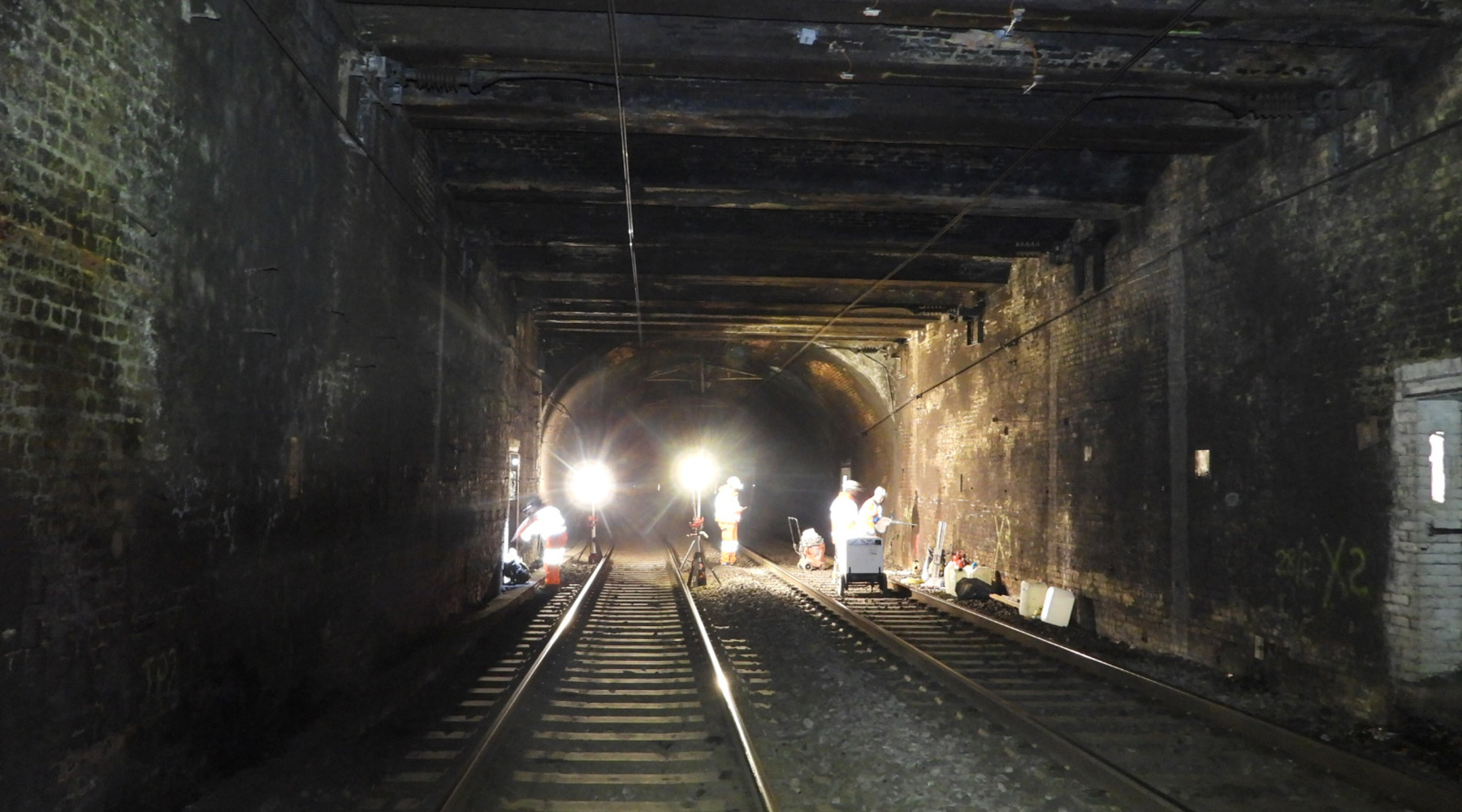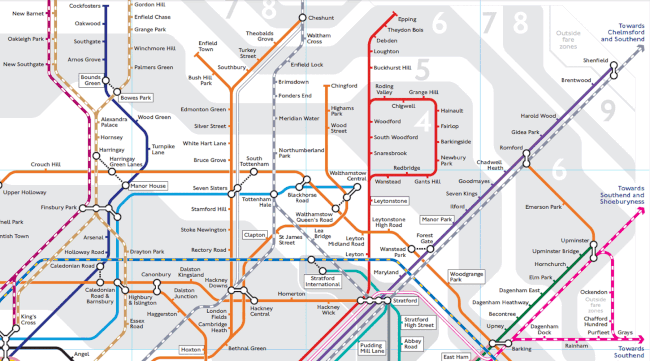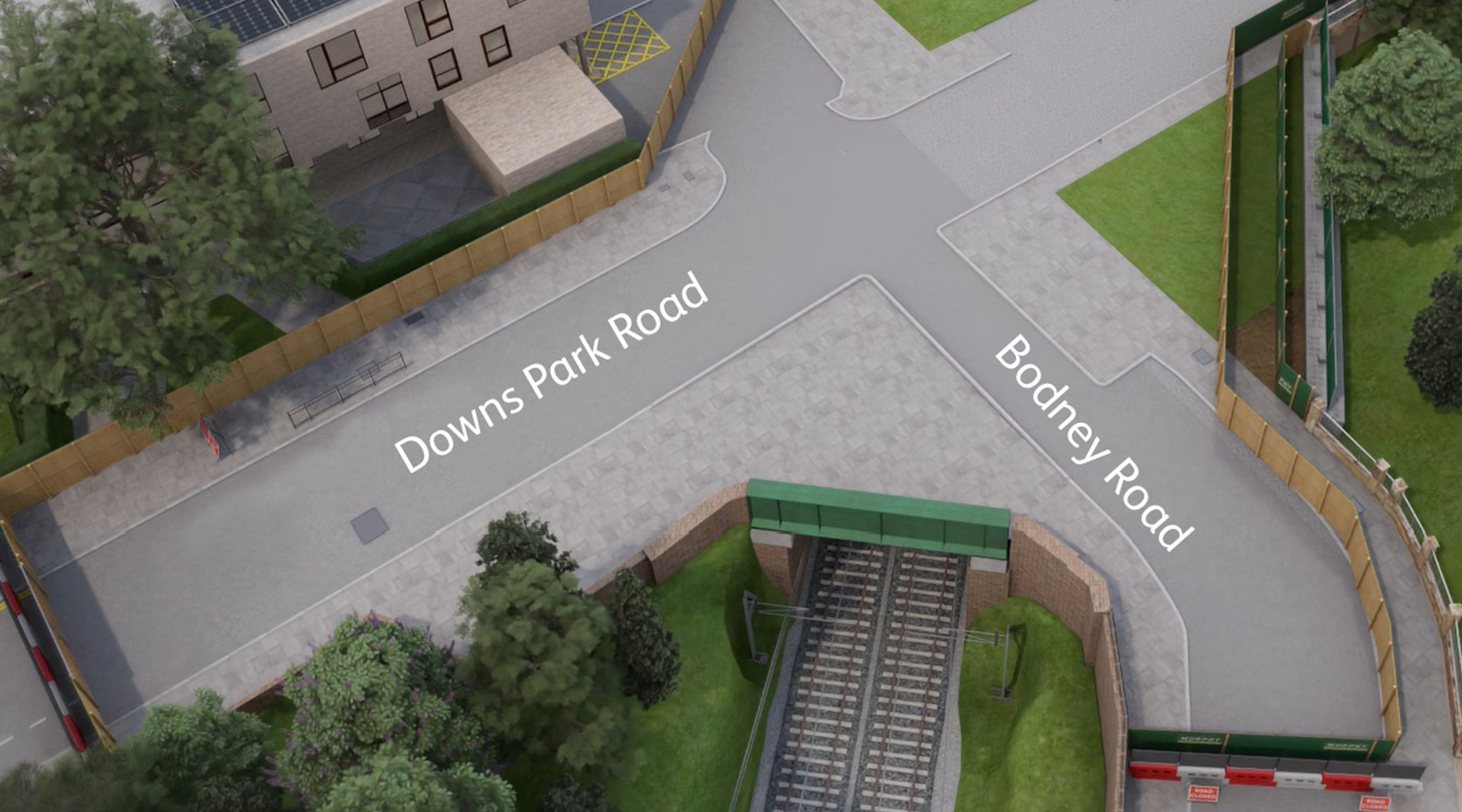The Liverpool Street to Chingford railway line will be closed for 16 days this summer as Network Rail replaces a large bridge supporting a road junction near the Hackney Downs.
This will affect both London Overground and Greater Anglia services that use the railway and some changes to other services that pass through the Hackney area of London.
The affected railway runs on arches above the streets along most of its length, but as it approaches the Hackney Downs, it dips down into a tunnel to pass under the park. When the Great Eastern Railway was planning its line back in the 1860s, they initially wanted to keep the railway above ground but conceded to digging a cutting to hide it — and later agreed to another compromise to turn the cutting into a tunnel.
The southern end of the tunnel is just outside Hackney Downs Park. It looks like part of the tunnel under the park, but it is actually a bridge over the railway, and it has reached the point where it needs replacing.
Network Rail says that between 20th July and 4th August (inclusive), engineers from Network Rail’s contractor, Murphy, will demolish the old bridge and start building the new one.
As a result:
No London Overground services will run between Hackney Downs and Chingford stations. This means there will be no rail service to or from Clapton, St James Street, Walthamstow Central, Wood Street, Highams Park and Chingford stations.
Also, Greater Anglia services that usually run between Liverpool Street and Hertford East will start and finish at Stratford instead. The usual Stratford – Meridian Water services won’t run, but other services will make additional stops at both Meridian Water and Northumberland Park.
Additionally, Liverpool Street to Cambridge / Stansted Airport services will be diverted via and call at Seven Sisters instead of Tottenham Hale. Bishop’s Stortford to Stratford services will not operate, with passengers advised to use alternative services.
To help:
The London Underground Victoria line from Walthamstow Central will be operating throughout this time to help people get around, including the Night Tube on Fridays and Saturdays.
Local buses will be running across the affected route.
Passengers wanting to travel between Liverpool Street and Hackney Downs / Bethnal Green will be able to use London Overground services running to and from Enfield Town and Cheshunt.
London Overground services to and from Enfield Town and Cheshunt may have different timetables during the 16 days, so regular passengers should check before they set off.
Work began on site last month, and the junction at Downs Park Road and Bodney Road is already closed to vehicles. The closure will be extended to pedestrians and cyclists from July 2024. The project is expected to be completed and Downs Park Road fully reopened by early 2025.
The new bridge is designed to last for 120 years – so put a note in your grandchildren’s diary for 2144 for the next closure.
Simon Milburn, Network Rail Anglia infrastructure director, said: “Thousands of people travel under and over this bridge every day by rail and road, and our project is vital to keeping their future journeys safe and reliable. We’re sorry for the disruption this summer but we’ll be working flat out to deliver a replacement bridge that will serve the community for generations to come.”










Looks to be a complicated job with it being a road junction on top of the railway and in a tight spotlike that.
Shame they couldn’t have at least kept some sort of service running between Chingford and at least Walthamstow.
As far as I can see, it would indeed be perfectly possible to run a 15 minute service from Chingford to Walthamstow Central. Indeed, I am about to make precisely that suggestion to Sir Ian Duncan-Smith, who I believe would be a good person to argue the case for doing that.
But first, can anybody give me a good reason (other than possible lack of foresight on the part of the planners) why this isn’t already a part of the proposal?
Openstreetmap shows a crossover https://www.openstreetmap.org/way/765450503/ just beyond Walthamstow Central on the way to St James Street. That surely is the main requirement to allow trains to run in both directions. And there are always plenty of trains parked overnight at Chingford anyway, so that shouldn’t be an issue.
There’s possibly an argument that they can’t safely run 10 carriage trains, because they are two units of 5+5 preventing the driver from walking the full length of the train without a platform. But they could presumably run a 5 carriage service at 10 minute intervals to give almost the same capacity.
The crossover might be there, but I don’t think the necessary shunting signals/signage is there to support a move in that direction.
Why would they build a crossover if it cannot be used?
Don Coleman
WRONG
In the past, Chingford – Walthamstow limited services have been run, when there were “inbound” engineering works.
Thanks NG. That’s great information.
But Don’s comment has also helped me structure my question to first confirm whether the crossover is *capable* of being used for that purpose, and then to justify *why* that solution is not being proposed.
They don’t necessarily need the crossover at Walthamstow Central. Unless they are taking the opportunity to do other major works on the Chingford branch, it should be possible to run two shuttle trains between Chingford and St. James St., or possibly even Clapton, each running under single line working rules locked in on the two tracks.
The crossover you refer to is an un-signalled crossover that is controlled by a ground frame.
To break this down into a real world answer:
1) The components of the crossover need to be full operational for the cross-over to work. However due to Network Rail (who are responsible for maintaining the railway infrastructure) underfunding from the government it there is a very real chance that it is clipped out of use and therefore cannot be used.
2) It is un-signalled & controlled by a ground frame (a small set of point levers close to the cross-over).
2a) To allow a train to use them, a “point setter” needs to be present to operate the groundframe and control the movement of trains.
2b) Each time the ground frame needs to be used the control of it needs to be relinquished from the signalling centre at Liverpool st and then reinstated – this takes time and therefore limits the amount of trains you can run (not really an issue with 2tph) but there is always a risk the ground frame cannot be locked out allowing the signaller take control of the signalling again – therefore trains then become trapped at Walthamstow Central.
3) Each train terminating at Walthamstow Central has to be detrained (emptied of passengers) before it can be allowed to shunt over the crossovers and back into platform 2.
This takes time and requires additional staff (££) to detrain the unit/prevent passengers from trying to board the train (which causes further delays – do not underestimate the willingness of the public to board any train and ignore announcements of “not in service”).
4) When operating in multiple (2×4 coach trains) there is no way for the driver to transfer between the units to “change ends” to start train back towards platform 2.
There is no walking route (safe pathway) for the driver to use to change ends (remember this is not an emergency)
– just to preempt any “its only a few yards” comments, nothing on the railway is level underfoot and is often littered with trip hazards therefore if the driver turns their ankle or ends up going down the embankment you then have a train that is stuck there and blocking any others from leaving Walthamstow Central –
So the only other option is to run 1×4 coach train (that’ll be “cozy” in the peak hours).
5) It is possible that during the shut down that Network Rail would use the opportunity to carry out maintenance work on other parts of the line that would not normally be possible in the small overnight engineering “window” they have between the first and last trains running.
Thanks for the excellent information you have given here.
I would still say it would be interesting to get the answer about whether the crossover is in good working condition. If it is not, then IDS is also the right person to ask why his party is starving the railways of the funding that is necessary to keep its equipment in good working order.
But as an alternative, is the double shuttle a feasible solution?
It’s a 9 minute journey, so the timings seem to work well:
* on track A, a full length train could leave Chingford at 55 and 25 minutes past each hour. It would arrive at Walthamstow 9 minutes later, allowing 6 minutes for the driver to change ends (via the platform), ready to depart at 10 and 40 minutes past each hour.
* on track B, a different full length train could leave Walthamstow 55 and 25 minutes past each hour. It would arrive at Chingford 9 minutes later, allowing 6 minutes for the driver to change ends (via the platform), ready to depart at 10 and 40 minutes past each hour.
* the result would be an overall 4tph service, identical to the normal running timetable (55, 10, 25, 40) when leaving Chingford and preserving the normal operating frequency (albeit at at different times of 10, 25, 40, 55) in the opposite direction.
* extra drivers would be needed at one of the stations to cover breaks, but that’s presumably no different to normal running.
If a 6 minute turnround can’t be achieved, then 3tph/20 minute service could certainly be achieved between the two shuttles. But with no junctions to cross, there shouldn’t be any unexpected delays.
a) Re “cozy” in last sentence of para. 4, these trains have huge capacity for standing passengers. Better to offer a “cozy” option by train than force everyone to take much slower alternative road routes.
b) Generally, apart from para. 5, I’m sorry to say this all reads like a ‘why we can’t’ approach to providing a train service rather than ‘how can we?’.